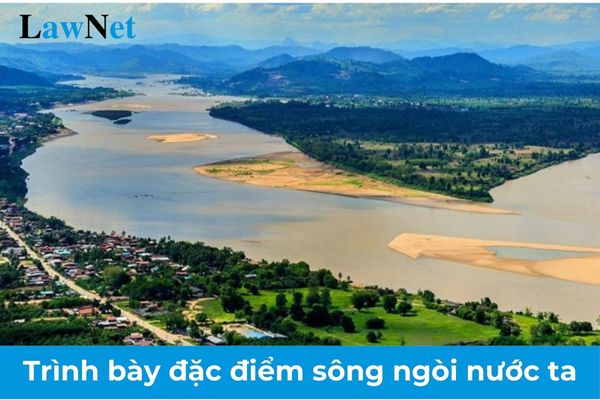What are the guidelines for specifying the characteristics of Vietnam's rivers? What are the standards for the principal of a lower secondary school in Vietnam?
What are the guidelines for specifying the characteristics of Vietnam's rivers?
With a dense and widespread river system, the rivers in Vietnam exhibit prominent characteristics in terms of density, water policies, and the influence of the tropical monsoon climate.
Below are suggested answers for the characteristics of Vietnam's rivers:
| 1. Dense River Network, Broad Distribution - Large number of rivers: Vietnam has about 2,360 rivers longer than 10 km, of which 93% are small and short rivers (watershed area of less than 500 km²). - Even distribution along the coast: On average, there is a river mouth every 20 km along the coast, creating a complex and abundant river system. - Flow direction: + Rivers in Vietnam mainly flow in two main directions: northwest - southeast (aligned with the topography of Vietnam) and in a circular arc (concentrated in the Northeast region and the Red River Delta). 2. Seasonal Water Regime - Distinct flood and dry seasons: + Flood season: Water levels rise and the current is strong, accounting for about 70 - 80% of the total annual water volume. Water volume during the flood season is often 2 - 3 times, in some places up to 4 times that of the dry season. + Dry season: River water levels drop significantly, and the current is weaker. 3. Abundant Water and Rich Silt - Rich water resources: + Vietnam's rivers transport about 839 billion m³ of water annually, providing a plentiful water source for production, domestic use, and the environment. - Fertile silt: + On average, each cubic meter of river water contains 223 grams of silty sand and dissolved substances, which helps replenish fertile silt to the deltas. + The total annual silt transported by rivers amounts to over 200 million tonnes, playing an important role in accreting and expanding large deltas such as the Red River Delta and the Mekong Delta. 4. Economic - Social Resources and Potential of Rivers - Providing water supply for living and irrigation: Rivers are an important water source for agricultural, industrial production and daily life. - Fishing and aquaculture: The river system is home to many aquatic species, contributing significantly to the local economy. - Hydropower development: Large rivers like Da River, Red River, Dong Nai River, Se San River have great hydropower potential, contributing to national economic development. - Transportation and transport: Rivers are an important transportation route, especially in the deltas like the Red River and the Mekong Delta. 5. Limitations and Challenges - Flood risk: During the rainy season, large rivers like the Red River, the Mekong River often cause floods, severely affecting life and production. - Water pollution: Uncontrolled industrial, agricultural, and domestic discharge is causing heavy pollution in many rivers, affecting health and the environment. - Water depletion during the dry season: Some small rivers dry up during the dry season, creating difficulties for production and daily life. Conclusion Vietnam's rivers, with a dense network, abundant water, and rich silt, bring significant economic, cultural, and social values and play an important role in maintaining the ecosystem. However, managing and sustainably exploiting river resources is an urgent task to minimize challenges and ensure long-term development. |
---
Note: The content is for reference only.

What are the guidelines for specifying the characteristics of Vietnam's rivers? What are the standards for the principal of a lower secondary school in Vietnam? (Image from the Internet)
What are the standards for the principal of a lower secondary school in Vietnam?
Under Clause 3, Article 11 of the lower secondary school, upper secondary school and multi-level school charter issued with Circular 32/2020/TT-BGDDT, the standards for the principal of a lower secondary school in Vietnam are stipulated as follows:
- Regarding qualifications and years of experience: meet the qualification standards of teachers provided for in the Education Law 2019 applicable to the in charged education level or to the highest education level of the multi-level school and have at least 05 years of teaching experience (or 04 years for mountainous areas, islands, remote and isolated areas, areas where ethnic minorities reside and particularly disadvantaged areas) in the in charged education level.
- Meet the standards provided for in the standards for principals of lower secondary schools, upper secondary schools and multi-level schools, which are in compliance with standards for principals of general education institutions promulgated by the Minister of Education and Training.
Who has the power to appoint the principal of a lower secondary school in Vietnam?
Pursuant to Clause 4, Article 11 of the lower secondary school, upper secondary school and multi-level school charter issued with Circular 32/2020/TT-BGDDT, the power to appoint the principal of a lower secondary school in Vietnam is defined as follows:
- Chairpersons of district-level People’s Committees have the power to appoint or recognize principals of lower secondary schools and multi-level schools the highest education level of which is lower secondary level.
- Procedures for appointment, recognition, reappointment and dismissal of principals and deputy principals are provided for by law.
- The person with competence in appointment of a principal of a lower secondary school also has the power to reappoint and dismiss such principal.

